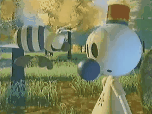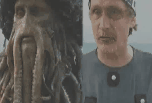1981
Looker
Michael Crichton’s science-fiction film Looker, marks the birth of 3D computer-generated characters in film. The research firm Digital Matrix offers a ‘paycheck for life’ to beautiful models willing to have their body digitally copied—allowing for future commercial use of the digital model.
‘Cindy’ is the latest super -model to be digitized; her digitization is visualized by a computer-generated simulation of her body being scanned. The shaded 3D-polygonal model of Cindy is the birth of 3D CGI characters in film.

1984
The Adventures of André and Wally B
The eighties mark the decade when film-making fully transitioned into the third dimension. The idea of setting characters into a 3D computer-generated setting was first conceptualized and fabricated by John Lasseter. At the time, Lasseter was a part of the Lucasfilm Computer Graphics Project, and produced the animation for the short film The Adventures of André and Wally B.
To smooth the transition to animation in 3D space, motion blurs were applied to the short's more dramatic sequences (as seen below).

1985
Tony De Peltrie
Featured as closing film of Siggraph '85, the largest computer animation festival in the world, Tony De Peltrie featured the first 3D computer generated human character with animated emotional expressions.
The producers & directors of the film, four graduates of the University of Montreal—Pierre Lachapelle, Philippe Bergeron, Pierrer Robidoux and Daniel Langlois—were praised by John Lasseter, one of the festival's judges,
“Years from now Tony de Peltrie will be looked upon as the landmark piece, where real, fleshy characters were first animated by computer”.

1988
Tin Toy
Striving for realism in 3D computer generated imagery became on of the industries polemic goals.
In 1986, Apple co-founder bought the Lucasfilm Computer Graphics Project and established Pixar— one of the most critically acclaimed film studios of all time. Two years later, Lasseter, now a part of Pixar Studios, produced Tin Toy, featuring the first digitally-animated character with life-like bendable arms and knees, surfaces and facial components.
Aiming for realism with computer graphics—creating realistic textured models & life-like motion animations—seems to succumb to a psychological constraint which roboticist Masahiro Mori describes as the Uncanny Valley.

1993
Jurassic Park
In Mori ’s article on the Uncanny Valley, he describes how the addition of movement, a sign of life, exaggerates the valley—causing deeper feelings of the uncanny. This is apparent in computer generated imagery, where early digital animators struggled with creating behavioral realism in their characters.
However, for the first time in computer generated imagery, a sign of life appeared in Steven Spielberg’s 1993 film Jurassic Park. The films unbelievable-real dinosaurs inspired awe and terror in movie goers around the world.
Although Spielberg initially imagined all the film’s creatures to be made by Stan Winston Studios with animatronics, a traditional animation technique, the advances in computer imagery urged Spielberg to at least try incorporating digital effects. Spielberg assigned his primary traditional animator Phil Tippett, of Tippett Studio, to direct & guide the special effects studio Industrial Light and Magic—a collaboration of the up-most success.
A main figure in this collaboration, Craig Hayes of Tippett Studio, is attributed with the creation of the Dinosaur Input Device (DiD); a device which served a pivotal role in the transition from stop-motion to computer animation. In a paper published by the collaboration, the DiD is described as:
“A system for animating an articulate figure using a physical skeleton, or armature, connected to a workstation. The skeleton is covered with sensors that monitor the orientations of the joints and send this information to the computer via custom-built hardware. The system is precise, fast, compact, and easy to use. It lets traditional stop-motion animators produce animation on a computer without requiring them to learn complex software. The working environment is very similar to the traditional environment but without the nuisances of lights, a camera, and delicate foam-latex skin. The resulting animation lacks the artifacts of stop-motion animation, the pops & jerkiness, and yet retains the intentional subtleties and hard stops that computer animation often lacks.”
Of Jurassic Park ’s fifty-two shots featuring computer animation, fifteen of them where created using the DiD, and a total of twenty dinosaur DiD armatures where created. The significance of the DiD conceptually is its acknowledgement of the complexity of motion and its departure from trying to make motion in virtual systems.

1995
Toy Story
Pixar’s Toy Story, following the success of Tin Toy, became the first feature-length 3D computer animated film. Before the team of 27 animators produced around 400 computer models to animate the film’s characters, models of each character where physically created with clay, plastic, and a whole range of miscellaneous materials.
Unique walking, talking, and jumping animations were designed for each character; then animators spent weeks matching characters mouths and facial expressions to those of the actor—weeks spent matching eight seconds intervals of the live actor ’s recordings.

1999
Star Wars Episode I: The Phantom Menace
The first extensive use of realistic computer generated imagery appears in Star Wars Episode I: The Phantom Menace; the film featured only one non-digitally altered scene. Backgrounds, special environmental effects, vehicles, crowds, and characters where all seamlessly integrated with the films live-action characters and settings.
The film features one of the first computer generated supporting cast members, Jar Jar Binks; scenes featuring Jar Jar and other digital characters where filmed twice: once with the voice actor ’s performance an then once without (to be filled by the digital character).
John Knoll, the film’s visual effects supervisor, is another major contributor in progression of realistic computer graphics in film.

2001
Final Fantasy: the Spirits Within
By the beginning of the twenty-first century computer generated imagery was becoming fairly common in both the film and television industry, and producing animation by means of recording a performers or an armatures movements were known as effective processes.
In 2001, the science fiction film Final Fantasy: the Spirits Within boldly attempted to cross over the Uncanny Valley and produce the most realistic CGI human characters as possible. Square Pictures, the film’s production studio was a Japanese-American animation and CGI collaboration based in Honolulu, Hawaii under the direction of Hironobu Sakaguchi. According to one of the studios animation director, animators debated on what made a character more human, the way it moved or the way it looked—and finally decided to focus on its look, particularly the face and fingers.
Consequently, Aki Ross, the film’s featured CGI character was composed of over 400,000 polygons. Unanimated, Aki was extraordinary realistic—as a marketing scheme, Aki was featured in the sexiest women ever list by Maxism, with readers voting her 87th out of 100. However, in the film, Aki’s motions and behaviorisms were not on par with her realistic image.
Ninety percent of the character’s body movements were animated by using motion capture techniques; however, key elements such as facial impressions, eye movements, and other minuscule intimacies of the human presence were not achieved with computer animations.
The human characters of Final Fantasy: the Spirits Within slipped into the Uncanny Valley due to the imbalance of visual and behavior realism.

2002
The Lord of the Rings: the Two Towers
To produce realistic behavior in computer generated characters, special-effects studios began translating more and more of the live-actor’s performance and behavior into their digital counter-parts. The level of detail the animator could extract from the recorded live-performance scaled inversely with feelings of uncanniness.
The Lord of the Rings: the Two Towers featured Gollum, the first photorealistic & behavioraly-realistic motion captured computer generated character to perfectly blend with other live actors.
Weta Digital, a special effects studio based in Wellington, New Zealand, based the virtual Gollum’s movements on most of actor Andy Serkis’ captured performances.

2007
Pirates of the Caribbean
Following Gollum, another notable realistic character produced by the mix of CGI and performance-capture, is Davy Jones from the Pirates of the Caribbean trilogy.
Davy Jones was brought to life by the performance of actor Bill Nighy blended with computer visuals by Industrial Light and Magic.

2009
UP
Produced by Pixar Animation Studios and Directed by Pete Docter, UP was Pixar ’s second animated film featuring humans as central characters.
In an attempt to stray from the uncannyness of Toy Stories human CGI characters, Pixar designed more abstracted and cartoony human characters. Carl, the films old protagonist has a squarish head, a visual metaphor for his obsession with his house; On the other hand, Ellie, Carls wife, has a head which resembles a balloon—a metaphor for her postive nature— which Carl finds comforting.
UP’s attempt of evading the Uncanny Valley, by departing from formal realism but preserving realism in behavior proves successful.

2009
Avatar
What are the implications of blending live performance with computer generated characters? The first and most obvious answer is fewer constraints and the possibilities of realities once dreamed of. As seen in James’ Cameron’s Avatar, the special effects studio Weta Digital has successfully translated 100% of an actor’s performance, behaviors, and expressions into their digital counter parts-the Na’vi.
On the other hand, by blending actors with CGI, the notion of what constitutes an ‘actor’ has been challenged. Some of Avatar’s star actors such as Zoe Saldana, whose performances were completely translated into their virtual counterparts (in Zoe’s case: Neytiri), where not included in the actor Academy Awards.
Addressing the subject, producer Steven Spielberg’s said, “I like to think of it as digital makeup, not augmented animation…It’s basically the actual performance of the actual actor, and what you’re simply experiencing is makeup…In the case of Avatar, the digital makeup is so thin you actually see everything that Zoe is doing. Every nuance of that performance comes through digitally.”
In the past, some believed live actors would disappear in place of virtual counterparts; today there’s a new dilemma-digital makeup has led some to believe the actor has disappeared.
Polygons to Digital Makeup
a look into 3D Computer Generated Imagery (CGI)
transitions through film media. works-cited



the Uncanny Valley
In his 1970 article Uncanny Valley in the publication Energy, roboticist Masahiro Mori describes a conjecture known as the uncanny valley: as a robot is made more humanlike in its appearance and motion, the emotional response from a human being to the robot will become increasingly positive and empathic, until a point is reached beyond which the response quickly becomes that of strong revulsion. However, as the appearance and 8motion continue to become less distinguishable from a human being, the emotional response becomes positive once more and approaches human-to-human empathy levels.
Although Mori ascribes this conjecture to the field of robotics, one can very well see its application in the field of CGI where similar ideas of striving for visual & behavioral realism occur.



works cited
Bukimi no tani (The uncanny valley).Mori, Masahiro.Energy 7(4),p.33-35.1970.
Dinosaur Input Device. Brian Knep, Craig Hayes, Rick Sayre, and Tom Williams. Presented at SIGCHI Conference on Human Factors in Computing Systems. URL: http://www.sigchi.org/chi95/proceedings/papers/bk_bdy.htm
Final Fantasy:The Spirits Within A Case Study. Jane Park.from a collection of Massachusetts Institute of Technology. URL(pdf):web.mit.edu/cms/Events/mit2/Abstracts/JanePark.pdf
Behind-the-scenes feature. Andy Serkis.Lord of the Rings:The Two Towers(limited edition).2006.URL(Youtube):http://www.youtube.com/watch?v=R_ENwZmE-Ec
THE OSCARS RANT: Sure, ‘Avatar’ is art — but is it animation?. Michael Cavna. The Washington Post .URL: http://voices.washingtonpost.com/comic-riffs/2010/03/the_rant_sure_avatar_is_art_–.
http://design.osu.edu/carlson/history/lesson11.html#pixar
http://www.pixar.com/index.html
http://www.adventuresinanimation.com/TonydePeltrie_.htm
http://www.filmsite.org/visualeffects.html
